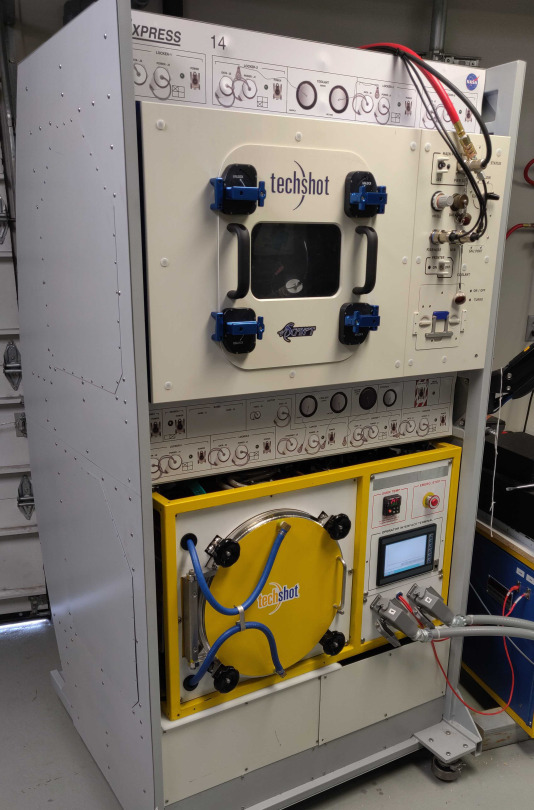The Ranks Of America’s Astronaut Corps Grew By 11 Today!
The ranks of America’s Astronaut Corps grew by 11 today!
After completing more than two years of basic training, our graduating class of astronauts is eligible for spaceflight. Assignments include the International Space Station, Artemis missions to the Moon, and ultimately, missions to Mars.
The class includes 11 astronauts, selected in 2017 from a record-setting pool of more than 18,000 applicants. This was more than double the previous record of 8,000 applicants set in 1978.
Meet the graduates:
Kayla Barron

“If you don’t love what you’re doing, you’re not going to be good at it. I think it’s a combination of finding things that you really love that will also be really challenging and will force you to grow along the way.”
This Washington native graduated from the U.S. Naval Academy with a bachelor’s degree in systems engineering. As a Gates Cambridge Scholar, which offers students an opportunity to pursue graduate study in the field of their choice at the University of Cambridge. Barron earned a master’s degree in nuclear engineering.
As a Submarine Warfare Officer, Barron was part of the first class of women commissioned into the submarine community, completing three strategic deterrent patrols aboard the USS Maine.
Zena Cardman

“Every STEM opportunity that I have ever gone down is because of some mentor who inspired me or some student who was ahead of me in school who inspired me.”
Zena Cardman is a native of Virginia and completed a bachelor’s degree in biology and master’s degree in marine sciences at The University of North Carolina, Chapel Hill. Her research has focused on microorganisms in subsurface environments, ranging from caves to deep sea sediments.
An intrepid explorer, Cardman’s field experience includes multiple Antarctic expeditions, work aboard research vessels as both scientist and crew, and NASA analog missions in British Columbia, Idaho, and Hawaii.
Raja Chari

“I grew up with the mentality that education is truly a gift not to be taken for granted.”
This Iowa native graduated from the U.S. Air Force Academy in 1999 with bachelor’s degrees in astronautical engineering and engineering science. He continued on to earn a master’s degree in aeronautics and astronautics from Massachusetts Institute of Technology (MIT) and graduated from the U.S. Naval Test Pilot School.
Chari served as the Commander of the 461st Flight Test Squadron and the Director of the F-35 Integrated Test Force. He has accumulated more than 2,000 hours of flight time in the F-35, F-15, F-16 and F-18 including F-15E combat missions in Operation Iraqi Freedom.
Matthew Dominick

“I get to work with incredible people that want to solve problems and are passionate about it. I really want to contribute to the world and this is how I want to do it.”
This Colorado native earned a bachelor’s degree in electrical engineering from the University of San Diego and a master’s degree in systems engineering from the Naval Postgraduate School. He also graduated from U.S. Naval Test Pilot School.
Dominick served on the USS Ronald Reagan as department head for Strike Fighter Squadron 115. He has more than 1,600 hours of flight time in 28 aircraft, 400 carrier-arrested landings and 61 combat missions.
Bob Hines

“As you get older, other things become important to you, like being a part of something that’s bigger than yourself. This human endeavor of exploration is something that’s really exciting.”
Bob Hines is a Pennsylvania native and earned a bachelor’s degree in aerospace engineering from Boston University. He is a graduate of the U.S. Air Force Test Pilot School, where he earned a master’s degree in flight test engineering. He continued on to earn a master’s degree in aerospace engineering from the University of Alabama.
Hines served in the U.S. Air Force and Air Force Reserves for 18 years. He also served as a research pilot at our Johnson Space Center. He has accumulated more than 3,500 hours of flight time in 41 different types of aircraft and has flown 76 combat missions in support of contingency operations around the world.
Warren Hoburg

“It was back in high school that I realized that I was really interested in engineering. I always liked taking things apart and understanding how things work and then I also really enjoy solving problems.”
Nicknamed “Woody”, this Pennsylvania native earned a bachelor’s degree in aeronautics and astronautics from MIT and a doctorate in electrical engineering and computer science from the University of California, Berkeley.
Hoburg was leading a research group at MIT at the time of his selection and is a two-time recipient of the AIAA Aeronautics and Astronautics Teaching Award in recognition of outstanding teaching.
Dr. Jonny Kim

“I fundamentally believed in the NASA mission of advancing our space frontier, all while developing innovation and new technologies that would benefit all of humankind.”
This California native trained and operated as a Navy SEAL, completing more than 100 combat operations and earning a Silver Star and Bronze Star with Combat “V”. Afterward, he went on to complete a degree in mathematics at the University of San Diego and a doctorate of medicine at Harvard Medical School.
Kim was a resident physician in emergency medicine with Partners Healthcare at Massachusetts General Hospital.
Jasmin Moghbeli

“Surround yourself with good people that have the characteristics that you want to grow in yourself. I think if you surround yourself with people like that you kind of bring each other up to a higher and higher level as you go.”
Jasmin Moghbeli, a U.S. Marine Corps major, considers Baldwin, New York, her hometown. She earned a bachelor’s degree in aerospace engineering with information technology at MIT, followed by a master’s degree in aerospace engineering from the Naval Postgraduate School.
She is a distinguished graduate of the U.S. Naval Test Pilot School and has accumulated more than 1,600 hours of flight time and 150 combat missions.
Loral O’Hara

“I’m one of those people who have wanted to be an astronaut since I was a little kid, and I think that came from an early obsession with flying – birds, airplanes, rockets.”
This Houston native earned a bachelor’s degree in aerospace engineering at the University of Kansas and a Master of Science degree in aeronautics and astronautics from Purdue University. As a student, she participated in multiple NASA internship programs, including the Reduced Gravity Student Flight Opportunities Program, the NASA Academy at Goddard Space Flight Center, and the internship program at the Jet Propulsion Laboratory.
O’Hara was a research engineer at Woods Hole Oceanographic Institution, where she worked on the engineering, test and operations of deep-ocean research submersibles and robots. She is also a private pilot and certified EMT and wilderness first responder.
Dr. Frank Rubio

“I just figured it was time to take the plunge and try it. And so, I did and beyond all dreams, it came true.”
Dr. Francisco “Frank” Rubio, a U.S. Army lieutenant colonel, is originally from Miami. He earned a bachelor’s degree in international relations from the U.S. Military Academy and earned a doctorate of medicine from the Uniformed Services University of the Health Sciences.
Rubio served as a UH-60 Blackhawk helicopter pilot and flew more than 1,100 hours, including more than 600 hours of combat and imminent danger time during deployments to Bosnia, Afghanistan, and Iraq. He is also a board certified family physician and flight surgeon.
Jessica Watkins

“I’ve always been interested in exploring space. What’s out there and how can we as humans reach those outer stars and how can we learn more information about who we are through that process.”
This Colorado native earned a bachelor’s degree in geological and environmental sciences at Stanford University, and a doctorate in geology from the University of California, Los Angeles. Watkins has worked at Ames Research Center and the Jet Propulsion Laboratory.
Watkins was a postdoctoral fellow at the California Institute of Technology, where she collaborated on the Mars Curiosity rover, participating in daily planning of rover activities and investigating the geologic history of the Red Planet.
Learn more about the new space heroes right here: https://www.nasa.gov/newastronauts
Make sure to follow us on Tumblr for your regular dose of space: http://nasa.tumblr.com.
More Posts from Thehkr and Others
Boo-tiful Ring Galaxies

A ghoulish secret lurks within each of these gorgeous galaxies. Their rings are dotted with stellar graveyards!

These objects are called ring galaxies, and scientists think most of them form in monster-sized crashes. Not just any galaxy collision will do the trick, though. To produce the treat of a ring, a smaller galaxy needs to ram through the center of a larger galaxy at just the perfect angle.

The collision causes ripples that disturb both galaxies. The gravitational shock causes dust, gas, and stars in the larger galaxy’s disk to rush outward. As this ring of material plows out from the galaxy’s center, gas clouds collide and trigger the birth of new stars.

In visible light, the blue areas in the galaxies’ rings show us where young, hot stars are growing up. Faint, pink regions around the ring mark stellar nurseries where even younger stars set hydrogen gas aglow.
The newborn stars come in a mix of sizes, from smaller ones like our Sun all the way up to huge stars with tens of times the Sun’s mass. And those massive stars live large!
While a star like our Sun will last many billions of years before running out of fuel, larger stars burn much brighter and faster. After just a few million years, the largest stars explode as supernovae. When massive stars die, they leave behind a stellar corpse, either a neutron star or black hole.

When we turn our X-ray telescopes to these ring galaxies, we see telltale signs of stellar remnants dotted throughout their ghostly circles. The purple dots in the X-ray image above are neutron stars or black holes that are siphoning off gas from a companion star, like a vampire. The gas reinvigorates stellar corpses, which heat up and emit X-rays. These gas-thirsty remains are beacons lighting the way to stellar graveyards.
Spiral galaxies — like our home galaxy, the Milky Way — have curved arms that appear to sweep out around a bright center. The dust and gas in those spiral arms press together, causing cycles of star formation that result in a more even mix of new stars and stellar corpses scattered throughout our galaxy. No creepy ring of stellar corpses here!
To visit some other eerie places in the universe, check out the latest additions to the Galaxy of Horrors poster series and follow NASA Universe on Twitter and Facebook for news about black holes, neutron stars, galaxies, and all the amazing objects outside our solar system.
Make sure to follow us on Tumblr for your regular dose of space: http://nasa.tumblr.com

Motivations are likely to be multifactorial and may be influenced by individual or organizational biases and competing interests.
An additional contributing factor is that individuals may be motivated to share information that they perceive to be both accurate and of social value.
Being a good friend doesn’t mean you always have all the right words to say. Sometimes it means you just know when to be a good listener.
Katrina Mayer (via quotemadness)
Tomorrow’s Technology on the Space Station Today
Tablets, smart appliances, and other technologies that are an indispensable part of daily life are no longer state-of-the-art compared to the research and technology development going on over our heads. As we celebrate 20 years of humans continuously living and working in space aboard the International Space Station, we’re recapping some of the out-of-this-world tech development and research being done on the orbiting lab too.
Our Space Technology Mission Directorate (STMD) helps redefine state-of-the-art tech for living and working in space. Here are 10 technologies tried and tested on the space station with helping hands from its astronaut occupants over the years.
1. Astronaut Wanna-Bees
Astronauts on the space station are responsible for everything from conducting science experiments and deploying satellites to tracking inventory and cleaning. While all are necessary, the crew can delegate some jobs to the newest robotic inhabitants – Astrobees.
These cube-shaped robots can work independently or in tandem, carrying out research activities. Once they prove themselves, the bots will take on some of the more time-consuming tasks, such as monitoring the status of dozens of experiments. The three robots – named Bumble, Honey, and Queen – can operate autonomously following a programmed set of instructions or controlled remotely. Each uses cameras for navigation, fans for propulsion, and a rechargeable battery for power. The robots also have a perching arm that lets them grip handrails or hold items. These free-flying helpers take advantage of another STMD technology called Gecko Grippers that “stick” to any surface.
2. Getting a Grip in Microgravity
We wanted to develop tools for grabbing space junk, and something strong and super-sticky is necessary to collect the diverse material orbiting Earth. So, engineers studied the gecko lizard, perhaps the most efficient “grabber” on this planet. Millions of extremely fine hairs on the bottom of their feet make an incredible amount of contact with surfaces so the gecko can hold onto anything. That inspired our engineers to create a similar material.
Now the Gecko Gripper made by OnRobot is sold on the commercial market, supporting industrial activities such as materials handling and assembly. The NASA gecko adhesive gripper that’s being tested in microgravity on the Astrobee robots was fabricated on Earth. But other small plastic parts can now be manufactured in space.

3. Make It, or Don’t Take It
Frequent resupply trips from Earth to the Moon, Mars, and other solar system bodies are simply not realistic. In order to become truly Earth-independent and increase sustainability, we had to come up with ways to manufacture supplies on demand.

A demonstration of the first 3D printer in space was tested on the space station in 2014, proving it worked in microgravity. This paved the way for the first commercial 3D printer in space, which is operated by Made In Space. It has successfully produced more than 150 parts since its activation in 2016. Designs for tools, parts, and many other objects are transmitted to the station by the company, which also oversees the print jobs. Different kinds of plastic filaments use heat and pressure in a process that’s similar to the way a hot glue gun works. The molten material is precisely deposited using a back-and-forth motion until the part forms. The next logical step for efficient 3D printing was using recycled plastics to create needed objects.
4. The Nine Lives of Plastic

To help fragile technology survive launch and keep food safe for consumption, NASA employs a lot of single-use plastics. That material is a valuable resource, so we are developing a number of ways to repurpose it. The Refabricator, delivered to the station in 2018, is designed to reuse everything from plastic bags to packing foam. The waste plastic is super-heated and transformed into the feedstock for its built-in 3D printer. The filament can be used repeatedly: a 3D-printed wrench that’s no longer needed can be dropped into the machine and used to make any one of the pre-programmed objects, such as a spoon. The dorm-fridge-sized machine created by Tethers Unlimited Inc. successfully manufactured its first object, but the technology experienced some issues in the bonding process likely due to microgravity’s effect on the materials. Thus, the Refabricator continues to undergo additional testing to perfect its performance.
5. Speed Metal

An upcoming hardware test on the station will try out a new kind of 3D printer. The on-demand digital manufacturing technology is capable of using different kinds of materials, including plastic and metals, to create new parts. We commissioned TechShot Inc. to build the hardware to fabricate objects made from aerospace-grade metals and electronics. On Earth, FabLab has already demonstrated its ability to manufacture strong, complex metal tools and other items. The unit includes a metal additive manufacturing process, furnace, and endmill for post-processing. It also has built-in monitoring for in-process inspection. When the FabLab is installed on the space station, it will be remotely operated by controllers on Earth. Right now, another printer created by the same company is doing a different kind of 3D printing on station.
6. A Doctor’s BFF
Today scientists are also learning to 3D print living tissues. However, the force of gravity on this planet makes it hard to print cells that maintain their shape. So on Earth, scientists use scaffolding to help keep the printed structures from collapsing.

The 3D BioFabrication Facility (BFF) created by TechShot Inc. could provide researchers a gamechanger that sidesteps the need to use scaffolds by bioprinting in microgravity. This first American bioprinter in space uses bio-inks that contain adult human cells along with a cell-culturing system to strengthen the tissue over time. Eventually, that means that these manufactured tissues will keep their shape once returned to Earth’s gravity! While the road to bioprinting human organs is likely still many years away, these efforts on the space station may move us closer to that much-needed capability for the more than 100,000 people on the wait list for organ transplant.
7. Growing Vitamins

Conditions in space are hard on the human body, and they also can be punishing on food. Regular deliveries of food to the space station refresh the supply of nutritious meals for astronauts. But prepackaged food stored on the Moon or sent to Mars in advance of astronauts could lose some nutritional value over time.
That’s why the BioNutrients experiment is underway. Two different strains of baker’s yeast which are engineered to produce essential nutrients on demand are being checked for shelf life in orbit. Samples of the yeast are being stored at room temperature aboard the space station and then are activated at different intervals, frozen, and returned to Earth for evaluation. These tests will allow scientists to check how long their specially-engineered microbes can be stored on the shelf, while still supplying fresh nutrients that humans need to stay healthy in space. Such microbes must be able to be stored for months, even years, to support the longer durations of exploration missions. If successful, these space-adapted organisms could also be engineered for the potential production of medicines. Similar organisms used in this system could provide fresh foods like yogurt or kefir on demand. Although designed for space, this system also could help provide nutrition for people in remote areas of our planet.
8. Rough and Ready
Everything from paints and container seals to switches and thermal protection systems must withstand the punishing environment of space. Atomic oxygen, charged-particle radiation, collisions with meteoroids and space debris, and temperature extremes (all combined with the vacuum) are just some conditions that are only found in space. Not all of these can be replicated on Earth. In 2001, we addressed this testing problem with the Materials International Space Station Experiment (MISSE). Technologists can send small samples of just about any technology or material into low-Earth orbit for six months or more. Mounted to the exterior of the space station, MISSE has tested more than 4,000 materials. More sophisticated hardware developed over time now supports automatic monitoring that sends photos and data back to researchers on Earth. Renamed the MISSE Flight Facility, this permanent external platform is now owned and operated by the small business, Alpha Space Test & Research Alliance LLC. The woman-owned company is developing two similar platforms for testing materials and technologies on the lunar surface.

9. Parachuting to Earth

Small satellites could provide a cheaper, faster way to deliver small payloads to Earth from the space station. To do just that, the Technology Education Satellite, or TechEdSat, develops the essential technologies with a series of CubeSats built by college students in partnership with NASA. In 2017, TechEdSat-6 deployed from the station, equipped with a custom-built parachute called exo-brake to see if a controlled de-orbit was possible. After popping out of the back of the CubeSat, struts and flexible cords warped the parachute like a wing to control the direction in which it travelled. The exo-brake uses atmospheric drag to steer a small satellite toward a designated landing site. The most recent mission in the series, TechEdSat-10, was deployed from the station in July with an improved version of an exo-brake. The CubeSat is actively being navigated to the target entry point in the vicinity of the NASA’s Wallops Flight Facility on Wallops Island, Virginia.
10. X-ray Vision for a Galactic Position System
Independent navigation for spacecraft in deep space is challenging because objects move rapidly and the distances between are measured in millions of miles, not the mere thousands of miles we’re used to on Earth. From a mission perched on the outside of the station, we were able to prove that X-rays from pulsars could be helpful. A number of spinning neutron stars consistently emit pulsating beams of X-rays, like the rotating beacon of a lighthouse. Because the rapid pulsations of light are extremely regular, they can provide the precise timing required to measure distances.
The Station Explorer for X-Ray Timing and Navigation (SEXTANT) demonstration conducted on the space station in 2017 successfully measured pulsar data and used navigation algorithms to locate the station as it moved in its orbit. The washing machine-sized hardware, which also produced new neutron star science via the Neutron star Interior Composition Explorer (NICER), can now be miniaturized to develop detectors and other hardware to make pulsar-based navigation available for use on future spacecraft.

As NASA continues to identify challenges and problems for upcoming deep space missions such as Artemis, human on Mars, and exploring distant moons such as Titan, STMD will continue to further technology development on the space station and Earth.
Make sure to follow us on Tumblr for your regular dose of space: http://nasa.tumblr.com
More than Just Dust in the Wind

From space, we can see a swirling brown mass making its way across the Atlantic – dust from the Sahara Desert – the largest hot desert in the world. It’s a normal phenomenon. Every year, winds carry millions of tons of dust from North Africa, usually during spring and summer in the Northern Hemisphere.

June 2020 has seen a massive plume of dust crossing the ocean. It’s so large it’s visible from one million miles away in space.

Dust clouds this large can affect air quality in regions where the dust arrives. The particles can also scatter the Sun’s light, making sunrises and sunsets more vibrant.

Dust particles in the air are also known as aerosols. We can measure aerosols, including dust, sea salt and smoke, from satellites and also use computer models to study how they move with the wind.

Following the transport of dust from space shows us how one of the driest places on Earth plays a role in fertilizing the Amazon rainforest. There are minerals in Saharan dust, like phosphorous, that exist in commercial fertilizers, helping seed the rainforest.

Make sure to follow us on Tumblr for your regular dose of space: http://nasa.tumblr.com
It’s sad when one has to paint a dark picture of another in order to paint a “perfect” picture of themselves.
Unknown (via quotemadness)
Name the Artemis Moonikin!
Choose your player!
As we gear up for our Artemis I mission to the Moon — the mission that will prepare us to send the first woman and the first person of color to the lunar surface — we have an important task for you (yes, you!). Artemis I will be the first integrated test flight of the Space Launch System (SLS) rocket and the Orion crew capsule. Although there won’t be any humans aboard Orion, there will be a very important crewmember: the Moonikin!
The Moonikin is a manikin, or anatomical human model, that will be used to gather data on the vibrations that human crewmembers will experience during future Artemis missions. But the Moonikin is currently missing something incredibly important — a name!
There are eight names in the running, and each one reflects an important piece of NASA’s past or a reference to the Artemis program:
1. ACE
ACE stands for Artemis Crew Explorer. This is a very practical name, as the Moonikin will be a member of the first official “crew” aboard Artemis I.
The Moonikin will occupy the commander’s seat inside Orion, be equipped with two radiation sensors, and wear a first-generation Orion Crew Survival System suit—a spacesuit astronauts will wear during launch, entry, and other dynamic phases of their missions. The Moonikin will also be accompanied by phantoms, which are manikins without arms or legs: Zohar from the Israel Space Agency and Helga from the German Aerospace Center. Zohar and Helga will be participating in an investigation called the Matroshka AstroRad Radiation Experiment, which will provide valuable data on radiation levels experienced during missions to the Moon.

2. Campos
Campos is a reference to Arturo Campos, an electrical engineer at NASA who was instrumental to bringing the Apollo 13 crew safely back home.
Apollo 13 was on its way to attempt the third Moon landing when an oxygen tank exploded and forced the mission to abort. With hundreds of thousands of miles left in the journey, mission control teams at Johnson Space Center were forced to quickly develop procedures to bring the astronauts back home while simultaneously conserving power, water, and heat. Apollo 13 is considered a “successful failure,” because of the experience gained in rescuing the crew. In addition to being a key player in these efforts, Campos also established and served as the first president of the League of United Latin American Citizens Council 660, which was composed of Mexican-American engineers at NASA.

3. Delos
On June 26, 2017, our Terra satellite captured this image of the thousands of islands scattered across the Aegean Sea. One notable group, the Cyclades, sits in the central region of the Aegean. They encircle the tiny, sacred island of Delos.
According to Greek mythology, Delos was the island where the twin gods Apollo and Artemis were born.
The name is a recognition of the lessons learned during the Apollo program. Dr. Abe Silverstein, former director of NASA’s Glenn Research Center, said that he chose the name “Apollo” for the NASA's first Moon landing program because image of "Apollo riding his chariot across the Sun was appropriate to the grand scale of the proposed program." Between 1969 and 1972, we successfully landed 12 humans on the lunar surface — providing us with invaluable information as the Artemis program gears up to send the first woman and the first person of color to the Moon.

4. Duhart
Duhart is a reference to Dr. Irene Duhart Long, the first African American woman to serve in the Senior Executive Service at Kennedy Space Center. As chief medical officer at the Florida spaceport, she was the first woman and the first person of color to hold that position. Her NASA career spanned 31 years.
Working in a male-dominated field, Long confronted — and overcame — many obstacles and challenges during her decorated career. She helped create the Spaceflight and Life Sciences Training Program at Kennedy, in partnership with Florida Agricultural and Mechanical University, a program that encouraged more women and people of color to explore careers in science.

5. Montgomery
Montgomery is a reference to Julius Montgomery, the first African American ever hired at the Cape Canaveral Air Force Station to work as a technical professional. After earning a bachelor's degree at Tuskegee Institute in Alabama, Montgomery served in the U.S. Air Force, where he earned a first class radio-telescope operator's license. Montgomery began his Cape Canaveral career in 1956 as a member of the “Range Rats,” technicians who repaired malfunctioning ballistic missiles.
Montgomery was also the first African American to desegregate and graduate from Brevard Engineering College, now the Florida Institute of Technology in Melbourne, Florida.

6. Rigel
Rigel is one of the 10 brightest stars in Earth's sky and forms part of the familiar constellation Orion. The blue supergiant is about 860 light-years from Earth.
The reference to Rigel is a nod toward the Orion spacecraft, which the Moonikin (and future Artemis astronauts!) will be riding aboard. Built to take humans farther than they’ve ever gone before, the Orion spacecraft will serve as the exploration vehicle that will carry crew into space and provide safe re-entry back to Earth.

7. Shackleton
Shackleton Crater is a crater on the Moon named after the Antarctic explorer, Ernest Shackleton. The interior of the crater receives almost no direct sunlight, which makes it very cold — the perfect place to find ice. Our Lunar Reconnaissance Orbiter spacecraft (LRO) returned data that ice may make up as much as 22% of the surface material in Shackleton!
Shackleton Crater is unique because even though most of it is permanently shadowed, three points on the rim remain collectively sunlit for more than 90% of the year. The crater is a prominent feature at the Moon’s South Pole, a region where NASA plans to send Artemis astronauts on future missions.

8. Wargo
Wargo is a reference to Michael Wargo, who represented NASA as the first Chief Exploration Scientist for the Human Exploration and Operations Mission Directorate at NASA Headquarters. He was a leading contributor to the Lunar Reconnaissance Orbiter and the Lunar Crater Observation and Sensing Satellite (LCROSS), which launched together on to the Moon and confirmed water existed there in 2009.
Throughout his time as an instructor at MIT and his 20-year career at NASA, Wargo was known as a science ambassador to the public, and for his ability to explain complex scientific challenges and discoveries to less technical audiences. Following his sudden death in 2013, the International Astronomical Union posthumously named a crater on the far side of the Moon in his honor.

Want to participate in the naming contest? Make sure you are following @NASAArtemis on Twitter, Facebook, and Instagram to get notified about the bracket challenges between June 16 and June 28! Learn more about the Name the Artemis Moonikin Challenge here.
Make sure to follow us on Tumblr for your regular dose of space: http://nasa.tumblr.com.

Take time to think, it is the source of power. Take time to read, it is the foundation of wisdom.




感染拡大の防止、医療インフラの整備、人々へのストレス軽減のために私たちそれぞれが自身の役割を果たすように求めています。
-
 vinceatlas liked this · 1 year ago
vinceatlas liked this · 1 year ago -
 alspictaideto liked this · 1 year ago
alspictaideto liked this · 1 year ago -
 percyjacksonwriter liked this · 2 years ago
percyjacksonwriter liked this · 2 years ago -
 swegadalious liked this · 3 years ago
swegadalious liked this · 3 years ago -
 inflightpilottraining liked this · 3 years ago
inflightpilottraining liked this · 3 years ago -
 pleek liked this · 4 years ago
pleek liked this · 4 years ago -
 kuoriainen liked this · 4 years ago
kuoriainen liked this · 4 years ago -
 vanesssa liked this · 4 years ago
vanesssa liked this · 4 years ago -
 jims-h liked this · 4 years ago
jims-h liked this · 4 years ago -
 sillyrhubarb liked this · 4 years ago
sillyrhubarb liked this · 4 years ago -
 npqn liked this · 4 years ago
npqn liked this · 4 years ago -
 alienwithaddiction liked this · 4 years ago
alienwithaddiction liked this · 4 years ago -
 kindabonhomie liked this · 4 years ago
kindabonhomie liked this · 4 years ago -
 takiminaa liked this · 4 years ago
takiminaa liked this · 4 years ago -
 greetings-fiends liked this · 4 years ago
greetings-fiends liked this · 4 years ago -
 tellme13secrets liked this · 4 years ago
tellme13secrets liked this · 4 years ago -
 sorryimsogrossfriend liked this · 4 years ago
sorryimsogrossfriend liked this · 4 years ago -
 reagay2531 liked this · 4 years ago
reagay2531 liked this · 4 years ago -
 swimming-in-stardust liked this · 4 years ago
swimming-in-stardust liked this · 4 years ago -
 red-robin-stan liked this · 4 years ago
red-robin-stan liked this · 4 years ago -
 magoskatsoufis liked this · 4 years ago
magoskatsoufis liked this · 4 years ago -
 nini6007 liked this · 5 years ago
nini6007 liked this · 5 years ago -
 confirmedworm liked this · 5 years ago
confirmedworm liked this · 5 years ago -
 iambasilgnome liked this · 5 years ago
iambasilgnome liked this · 5 years ago -
 enderfae liked this · 5 years ago
enderfae liked this · 5 years ago -
 millworker68 liked this · 5 years ago
millworker68 liked this · 5 years ago -
 albertg73 liked this · 5 years ago
albertg73 liked this · 5 years ago -
 buffy1958 liked this · 5 years ago
buffy1958 liked this · 5 years ago -
 usafphantom2 reblogged this · 5 years ago
usafphantom2 reblogged this · 5 years ago -
 usafphantom2 liked this · 5 years ago
usafphantom2 liked this · 5 years ago -
 kastianrose liked this · 5 years ago
kastianrose liked this · 5 years ago -
 thesupercuteandfuzzy liked this · 5 years ago
thesupercuteandfuzzy liked this · 5 years ago -
 theoriginaltraitor liked this · 5 years ago
theoriginaltraitor liked this · 5 years ago